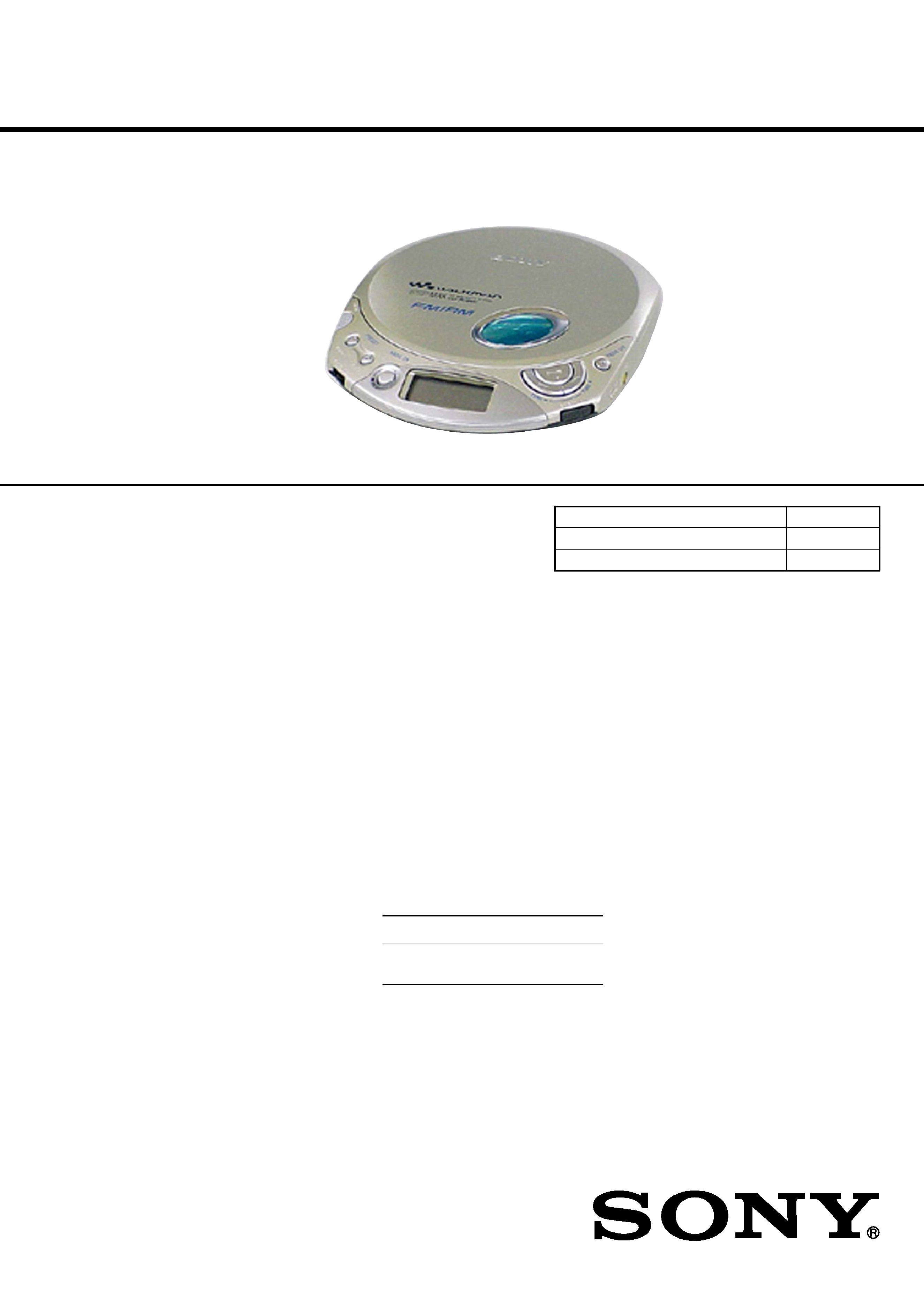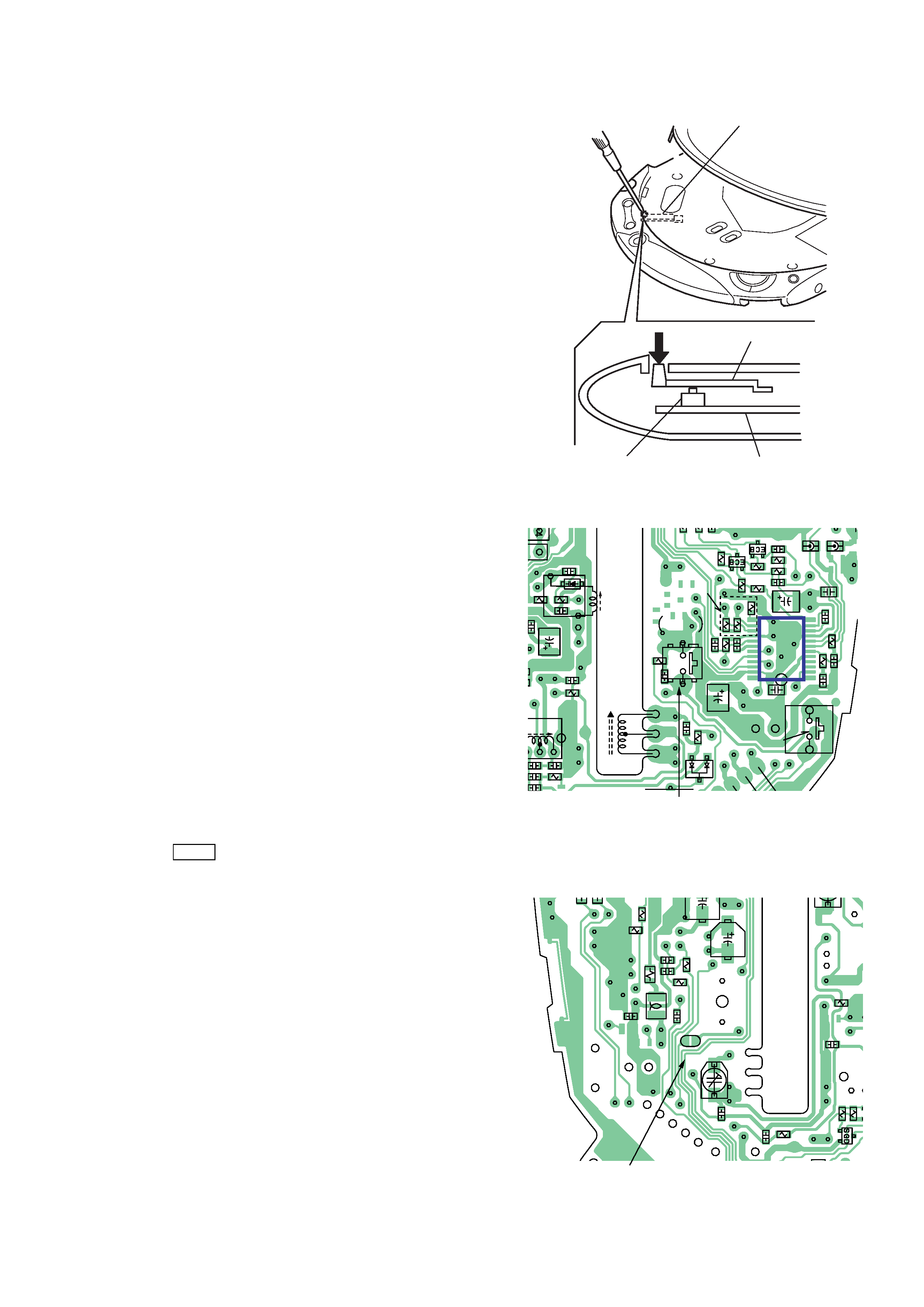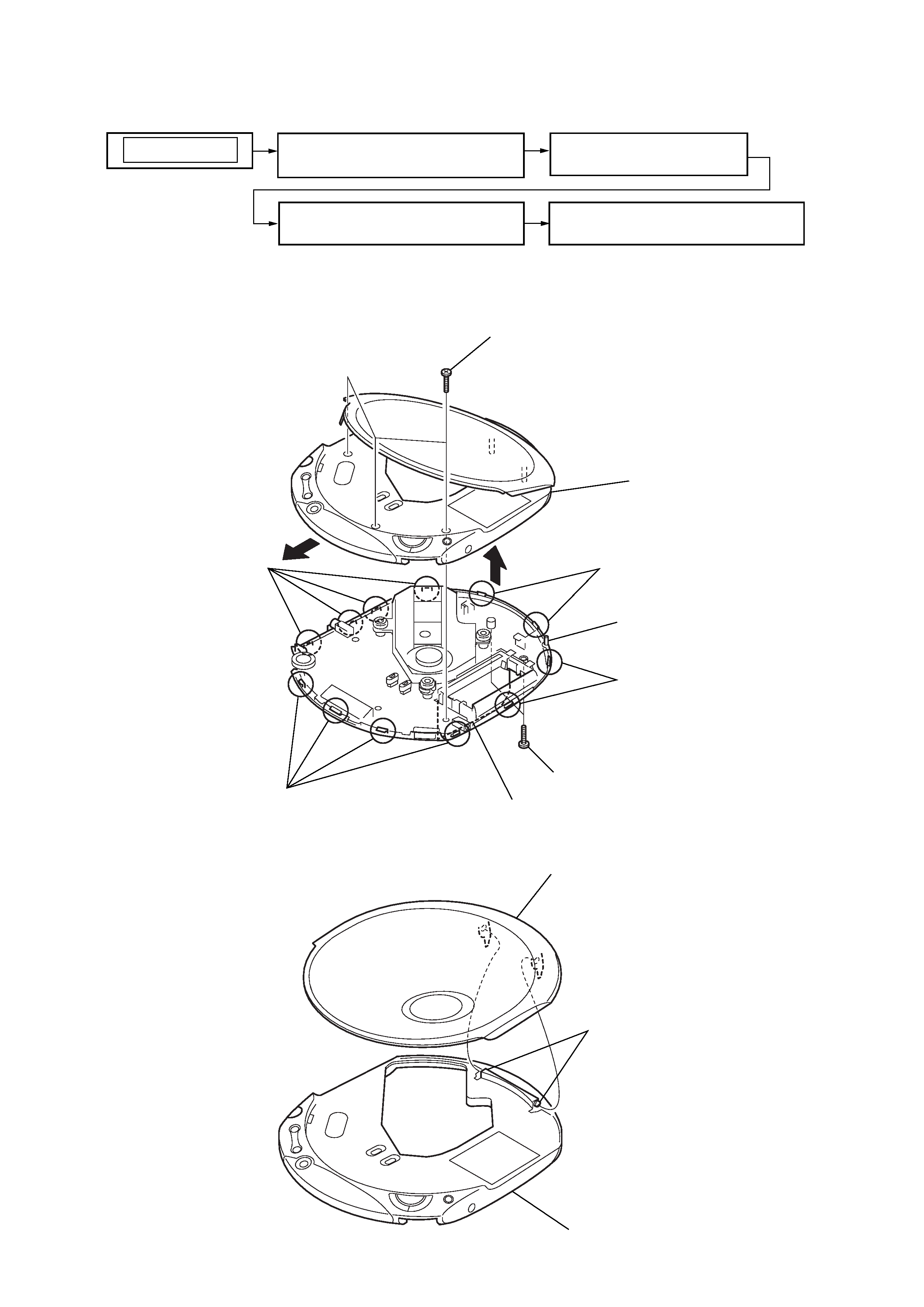
1
Model Name Using Similar Mechanism
D-EQ550
CD Mechanism Type
CDM-3125ER
Optical Pick-up Name
DAX-25E
SERVICE MANUAL
US Model
D-F200
Canadian Model
AEP Model
UK Model
E Model
Australian Model
Chinese Model
D-F201
D-F200/F201
FM/AM PORTABLE CD PLAYER
CD player
System
Compact disc digital audio system
Laser diode properties
Material: GaAlAs
Wavelength:
= 780 nm
Emission duration: Continuous
Laser output: Less than 44.6 µW (This output
is the value measured at a distance of 200 mm
from the objective lens surface on the optical
pick-up block with 7 mm aperture.)
D-A conversion
1-bit quartz time-axis control
Frequency response
20 20,000 Hz +1/3 dB
(measured by JEITA CP-307)
Output (at 4.5 V input level)
Headphones (stereo minijack)
· D-F200:
Approx. 5 mW + Approx. 5 mW
at 16 ohms
· D-F201:
Approx. 5 mW + Approx. 5 mW
at 16 ohms (Except FR model)
Approx. 0.2 mW + Approx. 0.2 mW
at 16 ohms (FR model)
Radio
Frequency range
· D-F200, F201 (CND, E13, E92, AUS,
MX, AR): (STEP switch)
9 kHz step:
FM: 87.5 108.0 MHz
AM: 531 1,710 kHz
10 kHz step:
FM: 87.5 108.0 MHz
AM: 530 1,710 kHz
· D-F201 (AEP, UK, FR, CET, CH):
FM: 87.5 108.0 MHz
AM: 531 1,602 kHz
SPECIFICATIONS
Antenna
FM: Headphones/earphones cord antenna
AM: Built-in ferrite bar antenna
General
Power requirements
For the area code of the model you purchased,
check the upper left side of the bar code on the
package.
·Two LR6 (size AA) batteries: 3 V DC
·AC power adaptor (DC IN 4.5 V jack):
US/CND/E92/MX model: 120 V, 60 Hz
AEP/E13/FR/CET model: 220 230 V,
50/60 Hz
UK model: 230 240 V, 50 Hz
AUS model: 240 V, 50 Hz
CH/AR model: 220 V, 50 Hz
Battery life* (approx. hours)
(When you use the CD player on a flat and stable
surface.)
Playing time varies depending on how the CD player
is used.
When using
ESP
RADIO
on
off
on
Two sony alkaline
31
33
70
batteries LR6(SG)
(produced in Japan)
* Measured value by the standard of JEITA
(Japan Electronics and Information Technology
Industries Association).
** Charging time varies depending on how the
rechargeable battery is used.
Operating temperature
5°C 35°C (41°F 95°F)
Dimensions (w/h/d) (excluding projecting
parts and controls)
Approx. 161
× 26.3 × 130.3 mm
(6 3/8
× 1 1/16 × 5 1/4 in.)
Mass (excluding accessories)
Approx. 210 g (7.5 oz.)
Supplied accessories
For the area code of the location in which you
purchased the CD player, check the upper left
side of the bar code on the package.
Headphones/earphones (1)
AC power adaptor (1) (D-F201)
Design and specifications are subject to change
without notice.
·Abbreviation
CND : Canadian model
E13 : AC 220 230V area in E model
E92 : AC 120V area in E model
AUS: Australian model
CH
: Chinese model
FR
: French model
CET : East European & CIS model
MX : Mexican model
AR
: Argentina model
Ver 1.0 2002. 05
9-874-005-01
2002E0400-1
© 2002.05
Sony Corporation
Personal Audio Company
Published by Sony Engineering Corporation

2
Flexible Circuit Board Repairing
· Keep the temperature of the soldering iron around 270°C during
repairing.
· Do not touch the soldering iron on the same conductor of the
circuit board (within 3 times).
· Be careful not to apply force on the conductor when soldering
or unsoldering.
Notes on Chip Component Replacement
· Never reuse a disconnected chip component.
· Notice that the minus side of a tantalum capacitor may be
damaged by heat.
TABLE OF CONTENTS
1. SERVICE NOTE ................................................................. 3
2. GENERAL
Getting started ......................................................................... 4
3. DISASSEMBLY
3-1. Cabinet (Upper) Assy .......................................................... 5
3-2. Upper Lid Assy ................................................................... 5
3-3. Main Board, MD Assy ........................................................ 6
3-4. Optical Pick-up, Motor ....................................................... 6
4. ELECTRICAL ADJUSTMENTS
Tuner Section ........................................................................... 7
CD Section .............................................................................. 8
5. DIAGRAMS
5-1. IC Pin Descriptions ............................................................. 9
5-2. Block Diagram CD Section ........................................... 15
5-3. Block Diagram Tuner Section ....................................... 16
5-4. Block Diagram Power Supply Section .......................... 17
5-5. Printed Wiring Board Main Section .............................. 18
5-6. Schematic Diagram Main Section (1/3) ......................... 20
5-7. Schematic Diagram Main Section (2/3) ......................... 21
5-8. Schematic Diagram Main Section (3/3) ......................... 22
5-9. IC Block Diagrams ............................................................ 23
6. EXPLODED VIEWS
6-1. Cabinet (Upper) Section .................................................... 25
6-2. Cabinet (Lower) Section ................................................... 26
6-3. CD Mechanism Deck Section (CDM-3125ER) ................ 27
7. ELECTRICAL PARTS LIST ........................................ 28
D-F200/F201
SAFETY-RELATED COMPONENT WARNING!!
COMPONENTS IDENTIFIED BY MARK 0 OR DOTTED LINE
WITH MARK 0 ON THE SCHEMATIC DIAGRAMS AND IN
THE PARTS LIST ARE CRITICAL TO SAFE OPERATION.
REPLACE THESE COMPONENTS WITH SONY PARTS WHOSE
PART NUMBERS APPEAR AS SHOWN IN THIS MANUAL OR
IN SUPPLEMENTS PUBLISHED BY SONY.
ATTENTION AU COMPOSANT AYANT RAPPORT
À LA SÉCURITÉ!!
LES COMPOSANTS IDENTIFIÉS PAR UNE MARQUE 0 SUR LES
DIAGRAMMES SCHÉMATIQUES ET LA LISTE DES PIÈCES
SONT CRITIQUES POUR LA SÉCURITÉ DE FONCTIONNEMENT.
NE REMPLACER CES COMPOSANTS QUE PAR DES PIÈCES
SONY DONT LES NUMÉROS SONT DONNÉS DANS CE MANUEL
OU DANS LES SUPPLÉMENTS PUBLIÉS PAR SONY.

3
D-F200/F201
L3
AM
FERRITE-
ROD
ANTENNA
L1
CD DOOR
OPEN
13
24
12
1
TP5
TP1
TP18
TP813
TP311
TP816
TP20
P75
D1
D2
C7
FB311 FB111
C10
16
R28
C2
C37
C41
C3
C46
C15
C254
C154
C319
R102
R202
R354
C350
C351
C30
C841
C300
R26
R6
R2
R9
R16
R3
C313
Q8
C13
R18
R254
R19
IC302
R841
R24
R154
Q7
R17
C359
R7
D3
C36
C34
R843
FR
MODEL
R317
C29
R27
C354
D304
C301
S810
L4
CF1
S801
S811
S801
MAIN BOARD (SIDE B)
TP416
Q53
C43
R72
R70
L312
CT3
C9
C8
C39
C204
C104
C318
C361
C353
R8
C352
C201
R353
TAP802
C360
R25
R101
R316
R201
D301
TAP802
MAIN BOARD (SIDE A)
SECTION 1
SERVICE NOTE
NOTES ON HANDLING THE OPTICAL PICK-UP BLOCK
OR BASE UNIT
The laser diode in the optical pick-up block may suffer electro-
static breakdown because of the potential difference generated by
the charged electrostatic load, etc. on clothing and the human body.
During repair, pay attention to electrostatic breakdown and also
use the procedure in the printed matter which is included in the
repair parts.
The flexible board is easily damaged and should be handled with
care.
Precautions for Checking Emission of Laser Diode
Laser light of the equipment is focused by the object lens in the
optical pick-up so that the light focuses on the reflection surface
of the disc. Therefore, be sure to keep your eyes more then 30 cm
apart from the object lens when you check the emission of laser
diode.
Before Replacing the Optical Pick-Up Block
Please be sure to check throughly the parameters as par the "Opti-
cal Pick-Up Block Checking Procedures" (Part No.: 9-960-027-
11) issued separately before replacing the optical pick-up block.
Note and specifications required to check are given below.
· FOK output : IC601 yg pin
When checking FOK, remove the lead wire to disc motor.
· RF signal P-to-P value : 0.45 ± 0.1 Vp-p
· The repairing grating holder is impossible.
Laser Diode Checking Methods
During normal operation of the equipment, emission of the laser
diode is prohibited unless the upper lid is closed while turning ON
the S801. (push switch type)
The following two checking methods for the laser diode are
operable.
· Method:
Emission of the laser diode is visually checked.
1. Open the upper lid.
2. With a disc not set, turn on the S801 with a screwdriver having a
thin tip as shown in Fig.1.
or TAP802 is shorted as shown in Fig.2.
Note: Do not push the detection lever strongly, or it may be bent
or damaged.
3. Press the N X button.
4. Observing the objective lens, check that the laser diode emits
light.
When the laser diode does not emit light, automatic power
control circuit or optical pick-up is faulty.
In this operation, the objective lens will move up and down 5
times along with inward motion for the focus search.
Fig. 2
Fig. 1
detection lever
detection lever
main board
S801

4
D-F200/F201
Locating the controls
For details, see pages in parentheses.
CD player (front)
1 i (headphones)
jack
7 Display
4 VOLUME
control
5 MENU/PRESET +
button
2 OPEN button
3 SOUND/
PRESET
button
qa DC IN 4.5 V
(external power
input) jack
8
u (play/pause)
button
9
x (stop) ·RADIO OFF
button
q; Strap holes
6 RADIO ON·BAND/
MEMORY button
qd HOLD switch
qs
./ >
(AMS/search) ·
TUNE /+ buttons
CD player (inside)
qg
AVLS switch
CD player (rear)
qf
ESP switch
qh LOCAL/DX switch : US, CND, E92, MX, AR model
MONO/ST (stereo) switch : AEP, UK, E13, AUS,
CH, FR, CET model
qk Battery compartment
qj STEP switch :
US, CND, E13, E92,
AUS, MX, AR model
SECTION 2
GENERAL
This section is extracted
from instruction manual.

5
D-F200/F201
Note : Follow the disassembly procedure in the numerical order given.
3-1. CABINET (UPPER) ASSY
3-2. UPPER LID ASSY
SECTION 3
DISASSEMBLY
· The equipment can be removed using the following procedure.
3-1.
CABINET (UPPER) ASSY
(Page 5)
3-2.
UPPER LID ASSY
(Page 5)
SET
3-3.
MAIN BOARD, MD ASSY
(Page 6)
3-4.
OPTICAL PICK-UP, MOTOR
(Page 6)
1
B 2x10
3
B 2x10
4
claws
0
cabinet (upper) sub assy
5
claws
6
claws
7
claws
8
9
2
battery case lid
boss
1
claws
2
upper lid assy
cabinet (upper) sub assy
